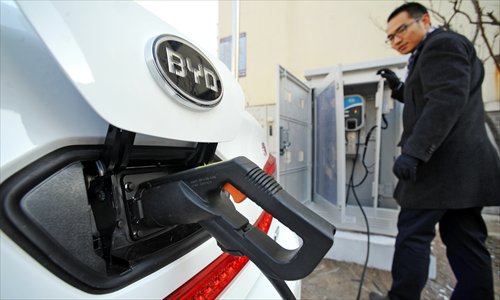China to extend new-energy car subsidies to 2020
Will be reduced gradually from 2017

A car owner in North China's Tianjin charges his electric car. Photo: CFP
China plans to extend a subsidy program for new-energy vehicles to 2020 though subsidies will be gradually reduced starting from 2017, read draft regulations posted on the website of the Ministry of Finance (MOF) on Tuesday.
In 2017, the subsidies for purchases of pure electric-powered vehicles and plug-in hybrid electric vehicles will be reduced by 10 percent from the subsidy amount in 2016, according to the subsidy policies for 2016-20. Meanwhile, the subsidies will be subject to another 10 percent reduction in 2019 from the rates approved for 2017.
The draft regulations were jointly created by the MOF, the Ministry of Science and Technology, the Ministry of Industry and Information Technology, and the National Development and Reform Commission.
The MOF said in a statement on its website that it is seeking public opinion on the draft regulations during a consultation period between Tuesday and January 30, 2015.
In February, the MOF said that the country is set to extend the subsidy program beyond 2015 and the subsidies will be gradually cut for 2014 and 2015.
The gradual decrease of subsidies is reasonable as the cost of production for new-energy vehicles producers declines for an increased scale of production as sales rise, Zhang Zhiyong, a Beijing-based independent auto analyst, told the Global Times Tuesday.
But instead of creating a set schedule of winding down the subsidies, relevant government bodies should allow for more flexibility in making policies to be in line with future sales, Zhang noted.
The draft regulations come as expected, therefore they are unlikely to cause any big fluctuations in the new-energy vehicle market either in terms of production or as measured by sales, Gao Jian, an industry analyst at Shanghai-based consultancy LMC Automotive, told the Global Times Tuesday.
The protracted subsidy program is of vital importance to the country's market for new-energy vehicles, which may otherwise be on the verge of survival, Gao remarked.
The country remains behind in its ambition of having 500,000 electric and plug-in hybrid vehicles on its roads by 2015 and 5 million by 2020, although a set of support measures have been taken to boost the market.
In a latest measure, the local government in Shenzhen in South China's Guangdong Province allocated 20,000 of its annual car ownership quota to the purchase of electric cars through a lottery process when it decided to place limits on car purchases on Monday.
In the first 11 months of 2014, China sold 53,000 new-energy vehicles, Beijing-based Securities Daily said in a report published on Tuesday.
The sales figures for the first 11 months, plus that logged over the course of 2013 - a total of 17,642 according to data from the China Association of Automobile Manufacturers - made up only a small portion of the target.
The new subsidy plan, among a series of preferential policies, would serve to give a boost to sales of new-energy vehicles, whereas the shortage of charging facilities nationwide might continue to be one of the biggest problems facing the industry, Gao said.
Currently, sales growth is still concentrated in the first-tier cities such as Shanghai where there have been restrictions on the purchase of traditional vehicles and a wider deployment of charging facilities for new-energy vehicles, he went on to say.